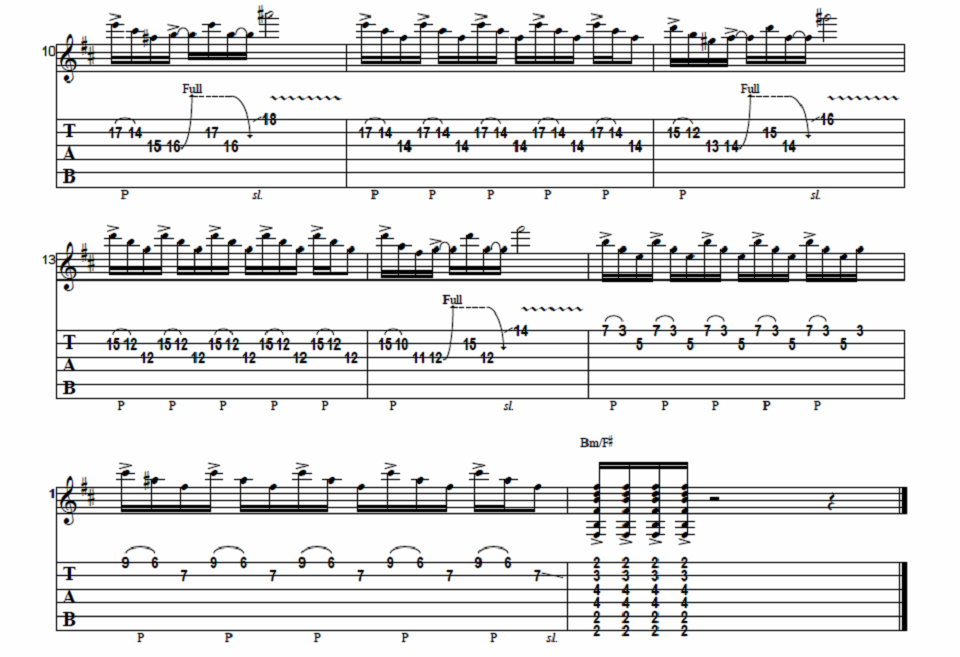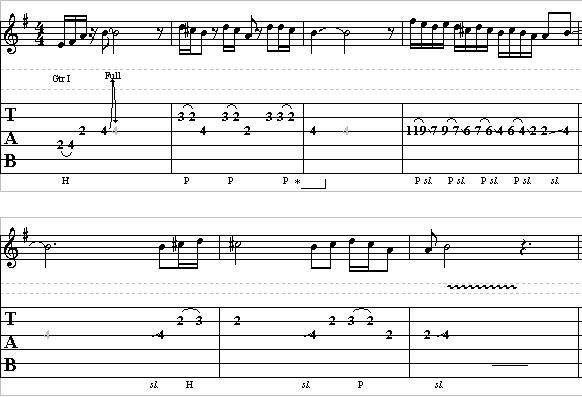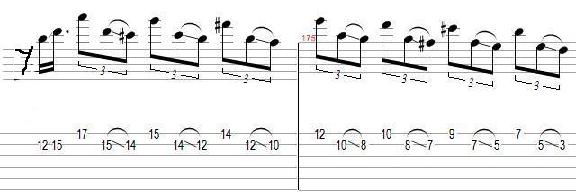Check out this killer solo in the style of Don Felder and Joe Walsh that you are sure to recognize from Guitar Control instructor Darrin Goodman, aka Uncle D. In this lesson Darrin breaks down this iconic solo with included tabs so you can easily follow along and master this legendary solo.


Introduction
How’s it going everybody? This is Darrin with GuitarControl.com bringing you this video lesson and today I’ve got some more lead guitar stuff for you. Today we’re going to be looking at the harmony outro solo on a Hotel California. So I used to think that this was completely just Don felder’s baby, but then recently I’ve read some things that are kind of conflicting to that. So I’m not really sure of the story. I always thought it was just Felder, but then I read something that gave me the impression that maybe Joe Walsh wrote this part of it, I don’t know. Also it sounds really good and it’s a really good exercise for arpeggios and to see kind of alternative ways that you can use them. And it’s so melodic because it follows the chord progression of the song.
So right now, Guitar Control is giving away this really awesome daily practice routine to improve your lead guitar chops. This was put together by our very own Silvio Gazquez, a two-time Guitar Idle finalist. This routine covers the four main concepts that are necessary for lead guitar; alternate picking, legato, sweep picking and tapping. All the tabs and exercises are all included in this free ebook and there’s a link in the description where you can get yours.
So be sure to click the link in the description for the tabs and let’s get close up and take a look at this.
Iconic Don Felder & Joe Walsh Solo
All right, so this one we’re starting off with this B minor arpeggio. So a lot of these shapes are ones that we’ve done on other lessons in the past. Or maybe you already know or from other songs. So what I’m doing is I’m on the 14th fret of the high E string with my pinky and then I’m on the 10th fret of the high string of my first finger. I’m going to pick 14 and pull to 10 and then follow that with the 12th fret on the B string and it’s a 16th note… So that’s just like a cool lick in itself. There’s so much stuff in here you’ll be able to use in other things. Okay, so we’ve got that and we do that for a whole measure. So we’ve got one, two, three, four and then the last note is an eighth note so it rings out for just a little bit longer because this is where we’re going to transition to the next part.
So for the next part we’re just going to move down so now we’re going to be on the 12th fret of the high E string with your pinky the ninth fret of the high E string with your first finger we’re going to pick and pull 12 to 9. Now we’re going to go to the 11th fret on the B string… So we went from this shape… so remember that because we’re going to be repeating a pattern of that. So we do this one once and we switch here… and then we slide all the way up to the 18th fret of the high E string… So that’s the basic idea of it and then it’s just somewhat going to be repeating that same concept as we’re working our way down. Okay, then we’re going to come back down to where we was and we’re going to pull 12 to 9, but instead of going to 11 on the B string we’re going to go to 10. So now we’re back to another different shape; as we go along this will make more sense. I’m getting a little ahead of myself. So now we’re gonna do the exact same timing, but now we’re going to shift down into the next pattern. So instead of 12, 9, 10, we’re going to go 7, 10, 9… So we’re back to that other shape, the second shape we did… So do the same idea, but this time we’re going to slide up to the 16th fret. So, so far we’ve got… Okay so now we’re going to come back to here again we’re going to do like what we did before and we’re going to go 10 to 7 and now we’re going to go to eight instead of going to nine, same timing again as what we’ve been doing… So when I’m doing these two by the way I pick the down stroke, whole, up stroke on the B string and then just… that seems to be the easiest way for me to do it. So now we’re gonna stay on ten, but now it’s gonna be awkward as we’re going to go 10 to 5 to seven on the B string… and then slide up to 14.
Then we’re going to move all the way down so we’re seven and three on the high E string and five on the B string. Then we’re gonna move back up to nine six and seven and then that’s like the halfway mark…
So to make that transition we’re going to come up to the 10th fret on the high E string with your middle finger and your first finger on the ninth fret and we’re going to go 10, 9, 10, 12 and then that’s going to put us back to the very first arpeggio again. So like I said that’s the halfway mark and then on the second half of this is just the same thing. There’s just some parts that are changed there’s some like little bluesy kind of licks almost and this whole thing is being harmonized. So this is the part I believe that Felder plays and then the harmony is what Joe Walsh plays, but I could be completely backwards, it doesn’t really matter. I really like this. They’re both great players and it’s just more great examples of how to write a solo like this that is very memorable. I think it’s one of the best ones ever, but that’s just my my humble opinion.
So now for the second half do the same thing. We’re going to 14 pull to 10 on the high E string to 12 on the B string. So we’re going to do a whole measure just like we did before, but now what we do next is the difference. Now we’re going to come up to the 17th fret on the B string with your pinky and then to the 14th fret on the B string and we’re going to pick and pull and then we’re going to use our middle finger to go to the 15th fret on the G string, third finger to go to the 16th fret and we’re going to bend and hold that and then use our pinky to grab 17 on the B string and then do a slide from nowhere to the 18th fret of the high E string just like what we did before… S o this second half is harder than the first half in my opinion. I can play the first half of it much better than I can play the second half. So that being said if you’re somewhat of a beginner just play the parts that you can play. Those are pretty big stretches and kind of tough and I’ve got little hands so if I can do it anybody can do it. But they might be really hard at first so just play the parts you can and have some satisfaction with that. Okay, so after we do that slide up to her up here to the 18th fret now we’re going to do the arpeggio a little bit different. We’re going to start on the 17th fret of the B string with your pinky and then you’re going to take your first finger and just barre the 14th fret of the B and G strings… same kind of idea that we’ve been doing. Now we’re going to move that down so we’re 15 pull the 12 and do another little another little lick it’s on the B string. 15 pull to 12 to the 13th fret of the G string with your second finger to the 14th fret and do that same bend and grab the 15th fret of the B string and then do the slide from nowhere again… Okay, so now after you do that slide to the 16th fret on the high E string we’re on to the next position. So now we’re on measure 13 so I’m going to be 15th fret on the B string with my pinky and I’m going to use my first finger barre the 12th fret of the high E and the B string and the G string on the 12th fret; same idea, pick pull, a whole measure of that. Then we’re going to shift clear down to 10 and pick pull and we’re gonna do the same thing that we did before, but this we have to do a little bit different this time. All right so we’re going to do that 15 pull to 10 on the B string to the 11th fret on the G string with my first finger and then I’m going to use my first finger just to move up to the 12 and do the bend, because otherwise it’s really awkward to do, it’s super awkward to do it anyway. You may end up finding an easier way to do it then how I’m doing it. Maybe you know if you have bigger hands it’s obviously going to be an advantage here, but yeah, that’s the most awkward part, and then slide to 14 and we’re just doing like what we did before. Now we’re back down to seven, pull the three to five and then we’re gonna move up to nine to pull the six to seven on the B string… and they slide out of it. Now on the audio on the studio version this just keeps going on and on and they fade it out. So I just ended it kind of like what they do on the live version of it… we come down and just do a regular old B minor chord, but if you barre all the way across then you get this little F sharp and it sounds nice and full…
Conclusion
Alright, so there you have it, the outro, melody, arpeggio lick, whatever you want to call it from Hotel California. So you like this lesson be sure to give me a thumbs up and leave a comment down below if you have any questions about this other guitar related topics. If you’ve not already done so please subscribe to the channel and hit that notification bell so you don’t miss any of the content that we upload throughout the week. Well that is all I have for you today. Thanks for watching and have a great day.



